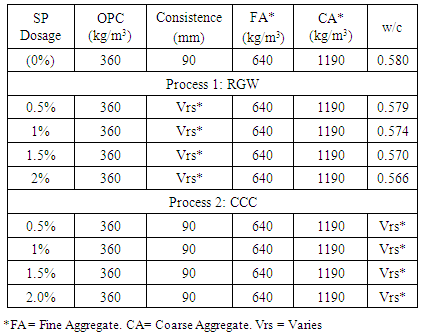-
Paper Information
- Paper Submission
-
Journal Information
- About This Journal
- Editorial Board
- Current Issue
- Archive
- Author Guidelines
- Contact Us
Journal of Civil Engineering Research
p-ISSN: 2163-2316 e-ISSN: 2163-2340
2018; 8(1): 9-14
doi:10.5923/j.jce.20180801.02

Current Effects of Naphthalene Based Superplasticizer’s Addition Process on Water Reduction and Grade C20/25 Concrete’s Compressive Strength
Sylvester O. Osuji, Dafe Ikogho
Department of Civil Engineering, University of Benin, Benin City, Nigeria
Correspondence to: Sylvester O. Osuji, Department of Civil Engineering, University of Benin, Benin City, Nigeria.
| Email: |  |
Copyright © 2018 Scientific & Academic Publishing. All Rights Reserved.
This work is licensed under the Creative Commons Attribution International License (CC BY).
http://creativecommons.org/licenses/by/4.0/

Superplasticizer was applied to concrete in two processes: addition of Superplasticizer to 25% of the gauging water adding remaining of gauging water by trials till a constant consistence is reached (CCC process) and by partial reduction of gauging water by amount of superplasticizer added (RGW process). Superplasticizer dosage range tested was limited to the manufacturer’s recommendation between 0% - 2% at 0.5% intervals of the binder mass. A total of 9 concrete mixes were produced, the control being plain concrete designed to attain a C20/25 grade concrete strength at 28days and the other 8 were produced varying only the Superplasticizer and water content. Fresh concrete’s consistence was measured by slump test, water reduction due to SP inclusion was observed and unconfined compressive strength tests performed at 1,7,28 and 56days. The study revealed SNF addition by the two different processes resulted in varying compressive strength development and water reduction recording maximum water reduction and compressive strength gains of 22.9% and 80.2% respectively compared to the control.
Keywords: Compressive strength gain, Concrete, Naphthalene based superplasticizers, Water reduction
Cite this paper: Sylvester O. Osuji, Dafe Ikogho, Current Effects of Naphthalene Based Superplasticizer’s Addition Process on Water Reduction and Grade C20/25 Concrete’s Compressive Strength, Journal of Civil Engineering Research, Vol. 8 No. 1, 2018, pp. 9-14. doi: 10.5923/j.jce.20180801.02.
Article Outline
1. Introduction
- It is widely known that compressive strength is an important parameter in the design and construction of civil concrete works. Compressive strength according to Abram’s law is increased with reduction in water/ cement (w/c) ratio inferring that water reduction leads to compressive strength increase. Superplasticizers are known to reduce water up to 30% [1], with modifications and sustained research, superplasticizers are improving in potency in improving concrete’s mechanical properties.Superplasticizers (SPs) are a class of anionic polymer dispersants that inhibit aggregation in hydraulic cement, lowering the yield stress of cement pastes improving workability and reduce water requirement [2]. Superplasticizers are employed in the production of high-strength concrete mostly required where reduced weight is important or where architectural considerations call for small support reducing the total amount of material placed and lowers the overall cost of the structure. When attempts are made to increase workability or reduce water or cement in concrete without admixtures, detrimental impact on critical concrete strength properties occur.Naphthalene based superplasticizers have been in use since 1930 [3], they are produced from naphthalene by oleum or sulfur trioxide sulfonation of the β- sulfonate [4]. Despite the long history and the advent of polycarboxylates superplasticizers, naphthalene based super plasticizers (SNF) are still in use today with brands being produced with refinements through research aimed at improving their performance. In a study carried out in [3], it was observed that they possess a low Relative Standard Deviation (RSD) values when used on different cement types compared to the new generation polycaboxylate superplasticizers.Numerous researchers have studied the effects of superplasticizers on concrete reporting how they improve concrete’s compressive strength [5-12]. According to [13], regular reporting of successful concrete applications relying on superplasticizers has led to a tendency to think of superplasticizers as a panacea for all concrete problems; however, good batch designs that consider the amount of superplasticisers to be added are critically important to avoid serious segregation, excessive bleeding, and needless extra expense. The right amount of superplasticizer within the manufacturers recommended range is not automatically known and has to be determined through experiments.The aim of this research is to investigate current effects of naphthalene based superplasticizer’s (SNF) on concrete’s compressive strength and water reduction estimating SNF’s optimum dosage in the different SP addition processes examined. The best results are attained when SP are applied at the optimal dosage within the manufacturer recommended dosage range. Reference [7] recommends that more concrete mixes containing different dosages of admixtures be prepared to obtain the precise optimum dosage of admixture at which maximum strength gain is achieved.There is the need to determine compressive strength gain and the optimum dosage so as to compensate for future strength losses. Situations arise where strength losses are experienced by concrete at elevated temperatures. Reference [14] reported a compressive strength loss of 43.88% when a C35/40 concrete was exposed to elevated temperatures of 300°C as experienced in facilities like reactor vessels of nuclear facilities. This study attempts to estimate compressive strength gain that can be achieved by use of SNF so as to compensate compressive strength losses that arise from loss of concrete exposed to elevated temperatures.
2. Literature Review
- Naphthalene based superplasticizer (SNF) is produced from naphthalene by oleum or sulfur trioxide sulfonation of β sulfonate. Subsequent reaction with formaldehyde leads to polymerization and the sulfonic acid [4] as shown in Figure 1. It is then neutralized with a suitable alkali and filtration to eliminate calcium sulfate [15].
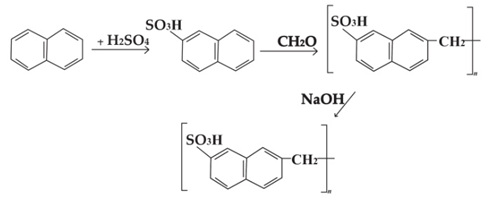 | Figure 1. SNF manufacturing process [4] |
3. Methodology
3.1. Material Properties
- The experimental work was carried out using basic constituents of concrete such as coarse aggregates, fine aggregates, cement, water and superplasticizer. The constituents used were as follows: Coarse Aggregates: The coarse aggregate used was crushed and angular shaped of maximum size 40mm granite from Ofosu, Ondo State. Particle size distribution is shown in Figure 2 and physical properties shown in Table 1.
|
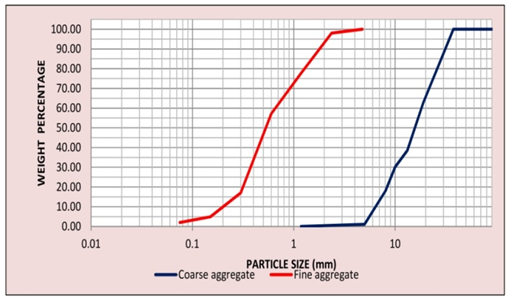 | Figure 2. Particle size distribution of fine and coarse aggregates |
|
3.2. Concrete Mix Proportion and SNF Addition Process
- A total of nine concrete mixes were made and SNF was added to concrete from 0.5% to 2% according to the mass of cement within manufacturers recommendation by the following two different processes:(a) In the first process gauging water was replaced by the amount of the SP which was added. This process will be denoted as RGW in what follows.(b) In the second process a delayed addition of the SP to 25% of the gauging water was done. Then water was added by trials till a constant concrete consistence of 90mm was attained. This method will be denoted as CCC in what follows.Control mix was designed using the department of envi ronment (DOE) method for a 28 day strength of 25N/mm2 with 0% SP. The other 8 concrete mixes were produced by applying the SP using the two methods described above from 0.5% to 2% at 0.5% intervals of the cement mass as shown in Table 3. Consistence was determined for all fresh concrete mixes by the conventional slump test in accordance to BS EN 12350: 2. After checking the consistence, mixed concrete was placed in a cast iron mould and was well compacted in two layers with the help of a table vibrator for 45 and 30 seconds for double and single cast iron moulds respectively. They were kept for 24 hours and then the casted concrete cubes were demoulded producing a 150 x 150 x 150mm concrete specimens. The specimens were then exposed to continuous moist curing at 100% relative humidity (Wet –cured) in accordance to BS EN 12390 part 2: 2000. Compressive strength tests were performed at 1, 7, 28 and 56 days in accordance to BS EN 12390:4 using a compression testing machine. The mean of three results was recorded as the compressive strength. Water reduction due to SP’s addition was also recorded.
|
4. Results and Discussions
- There is a general increase in both compressive strength and water reduction as SNF dosage increases. The compressive strength test results due to SNF partial replacement of water at the different doses (RGW) at 1, 7, 28 and 56 days are plotted in Figure 3. The compressive strength development due to SNF’s addition by CCC process is shown in Figure 4. Water reductions observed as a result of method of addition of SP are plotted in Figure 5 and the effect of SP dosage on initial slump by RGW and CCC processes is presented in Figure 6. There is a general increase in compressive strength with time as seen in Figures 3 and 4. Water reduction from initial gauging water increases as SP dosage increases in both CCC and RGW SP addition processes as seen in Figure 6. Results also show a trend of increase in SP dosage and a corresponding decrease in w/c ratio as seen in Figure 6.
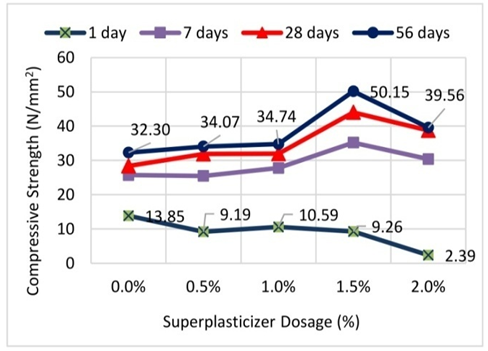 | Figure 3. 1, 7, 28 and 56 day compressive strength development due to SP partial replacement of water (RGW) |
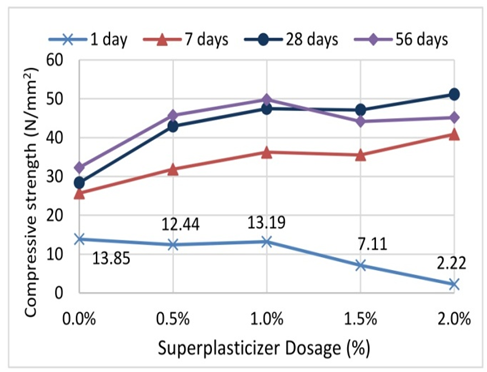 | Figure 4. Compressive strength development due to SNF addition to attain constant consistence (CCC) |
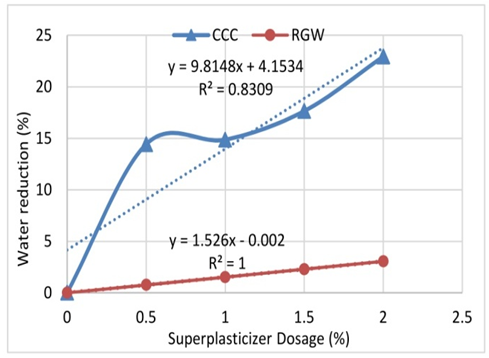 | Figure 5. Water reduction attained by use of SNF |
 | Figure 6. Effect of SP dosage on initial slump by RGW and CCC |
4.1. Effect of SNF on Grade C20/25 Grade Concrete’s Compressive Strength
- It is observed that there is a general compressive strength increase with time over the range of doses tested compared to the control regardless of which SNF addition process was applied as shown in Figures 3 and 4. 1 day compressive strength however, are observed to have lower compressive strengths than the control.SNF added by the CCC process showed significant increase in 7 and 28day compressive strength as observed in Figure 4. 56 days compressive strength increased up to 1% SP dosage and then loss in strength was observed at 1.5% and 2%. This loss is unexplained.SNF added to concrete through the CCC process failed to behave as a superplasticizer as per EN 934-2 1 day compressive strength gain requirement but passed the 28 day strength requirement over all doses tested based on requirements of EN 934-2. Results showed that at 0.5%, 1%, 1.5%, and 2% dosage, 28 day compressive strengths are 151%, 167%, 166% and 180% of the control respectively at equal consistence. Although there is no EN 934-2 specification for the behaviour of SP at 56days, it is observed that the reduction in compressive strength at 1.5% and 2% corresponds to the sharp increase in water reduction at same SP doses as shown in Figure 5.The early low compressive strength loss can be attributed to the superplasticizer delaying the action of C3S and C3A [7]. Strength gain was improved at 7 and 28 days over the range of doses examined. The superplasticizer despite its low early strength, at 28 days is observed to turn a C20/C25 concrete to a C40/50 concrete at 2% dosage as shown in Figure 4 a compressive strength gain 80% higher than the control.SNF applied by the RGW process, resulted in a general increase in compressive strength. The estimated optimum dosage based on the highest attained compressive strength is 1.5% (Figure 3). As per clause 8.2.1.2 of BS EN 206 (2013), a variation greater than 15% from the mean compressive strength is significant. If this is adopted as basis of comparism of the strengths to the control, SNF added through RGW process at 0.5% and 1% caused no significant increase at 7 day compressive strength. Compressive strength variations are pronounced between 1% and 2% see Figure 3. This coincides with the drastic increase in percentage water reduction at 1.5% to 2% increased water reduction as a result of the SNF’s elctrosteric action see Table 4. At this SP dosage, significant strength increases of 37% and 18% respectively were observed. At 28 day strengths only 1.5 and 2% caused significant compressive strength increase (Figure 3).It is observed that compressive strength development is slower with the RGW SP addition process compared to the CCC process (Figure 3). This is as a result of water reduction limited to SP amount added and the interaction of the SP with the cement particles by electrosteric action.
|
4.2. Water Reduction Due to SP Addition by CCC
- Addition of SNF by CCC process led to water reduction with increasing SP dosage as shown in Table 4. Results indicate that water cement ratio decreases with increase in SNF dosage as shown in Figure 5. Optimum water reduction in concrete mix due to addition of SNF by CCC is 22.93% at 2% dosage at constant concrete slump of 90mm as shown in Figure 5. Water reductions made possible by addition of SNF by CCC at constant slump increase with the increase in SNF dosage as shown in Table 4. EN 934 superplasticizer requirements for water reduction were met for all doses examined. Water reduction is possible due to the deflocculation of cement particles caused by the superplasticizer’s electrosteric action making the fresh concrete more fluid making it require less water to attain the consistence of the control. Water reduction is observed to be higher with CCC SP addition process compared to the RGW process as seen in Figure 6.
4.3. Water Reduction Due to SP Addition by RGW
- SNF applied by RGW led to water reduction of 0.76%, 1.52%, 2.29% and 3.05% at 0.5%, 1%, 1.5% and 2% SP dosage respectively much less than water reductions attained by the CCC SP addition process as shown in Figure 5. The indirect relationship between the SP dosage and w/c ratio is observed (w/c ratio decreases with increase in SP dosage) as seen in Figure 6. This is expected as water saved is limited to only the amount of SP added compared to the CCC method where water reduction is 20% greater. RGW process led to improved slump across the dosages (Figure 6). It is observed that there is improvement in slump when RGW is preformed resulting in an increase in slump up to 213mm from initial 90mm. The increase in slump is attributed to electrosteric rejection due to the high charge of SO3 groups from SNF on the surface of cement particles [24].
5. Conclusions
- An investigation has been performed to study the current effects of SNF’s superplasticizer’s addition process on water reduction and grade C20/25 concrete’s compressive strength. From the results presented earlier, the following conclusions are drawn:SNF addition to concrete mixes by CCC and RGW processes led to maximum water reductions of 22.93% and 3.05% respectively at SP dosage of 2%.SNF applied by RGW process led to a 55% compressive strength gain and a 137% increase in slump producing a C32/40 grade concrete at estimated optimum dosage of 1.5% compared to C20/25 grade concrete of the control at 28 days. Optimum superplasticizer dosage based on compressive strength is 1.5% when SNF partially replaces gauging water. At this dosage, a 55% compressive strength increase and a slump 137% slump increase is observed transforming a 28 day C25/30 grade concrete to a C32/40 grade concrete.The SNF addition to concrete by CCC addition process led to compressive strength gain of 80% turning a C20/25 concrete to C40/50 with constant slump of 90mm with an estimated optimum dosage of 2%. The maximum dosage recommended by the manufacturer. SNF addition by the CCC and RGW processes to concrete generally improved concrete’s compressive strength at 7, 28 and 56 days with SNF failing to improve 1day compressive strength in both processes. SNF applied by CCC process however led to a strength loss at 56 days. Water reductions of 22.93% in concrete mix is possible by inclusion of SNF to concrete. The process of application at the right dosage of the superplasticizers leads to increased compressive strengths. Situations arise when high compressive strength is desired, SNF should be applied at maximum dosage recommended by the manufacturer with control slump maintained if convenient. However, if workability improvement is the controlling criteria, SNF should be added to partially replace water at the optimum dosage. This small water reduction by SP amount has been shown to contribute to compressive strength gain.
 Abstract
Abstract Reference
Reference Full-Text PDF
Full-Text PDF Full-text HTML
Full-text HTML

